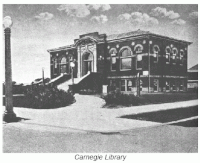Huntington Beach Public Library
It offers online databases, print and electronic books and magazines, children's programs, computer lab, DVDs, CDs, and audiobooks for anyone with a Huntington Beach Library card.
Volunteers also subsidize the library system by selling used books, operating a gift shop, and running charitable events.
Local business and residents have held special events such as seminars, classes, weddings, auditions, jazz concerts and film festivals at the central location.
Additionally, several community organizations use Central: Literacy Volunteers of America help adults learn to read; the Huntington Beach Art League hosts art shows; the Orange County, California Genealogical Society houses a depository of records; and the Huntington Beach Playhouse produces several shows a year in the library theater.
[2] This quaint branch in the southeast section of the city began as a former real estate sales office located on 9281 Banning Ave.
[2] The library system offers many information services to home users via the Internet such as electronic databases and downloadable audiobooks and ebooks.
From the convenience of home, library patrons have access to a wealth of authoritative factual information that is not freely available on the Internet.
From the beginning the Huntington Beach Public Library has been an illustration of citizen concern for the community and its future generations.
Shortly before the city was incorporated February 1909, the possibility of opening a library was brought to the attention of the Board of Trade by two citizens, R. W. Blodgett and Mrs. R. H. Lindgren.
Efforts of these two citizens aroused the interest of some local organizations and the Huntington Beach Women's Club called a mass meeting on February 15, 1909, to form a library association.
Mr. S. E. Hearn agreed to allow the board to move the building to a lot at the corner of Walnut Avenue and Main Street for a nominal rent charge.
Andrews was granted a leave of absence from her librarian's job in March 1911, and when she failed to return, Bertha Proctor was permanently appointed to take her place in May.
The main floor of the new Carnegie Library housed an adult reading room, a children's department and the librarian's office.
In March 1933, the Carnegie Library suffered considerable damage in the 1933 Long Beach earthquake which struck the area.
A preliminary set of plans was submitted to the Library Board by Architects McClelland, McDonald, and Markwith of Los Angeles, but the advent of World War II held up construction until 1949.
Members of the Library Board at the time of the dedication were Pearl M. Jones, president, Berta Tovatt, J. K. McDonald, Edith Vavra, and G. H. Hasson.
Shortly before the actual signing of the agreement, Richard Neutra died while on tour and his son, Dion, was retained to design the project.
A 10-acre (40,000 m2) plot of land was purchased for the site, including part of Talbert Lake, and the ground breaking ceremony took place on October 28, 1972.
The library increased its role as a vital community cultural center throughout the following two decades, and by the early 1990s plans were underway to expand its services.
[7] The late 1990s and early 2000s saw the emergence of a "virtual" branch when the library began offering a web-based catalog of its holdings and online reference databases.
With help from the Bill and Melinda Gates Foundation, the library embraced the Information Age by providing computer labs with free Internet access.
In 2005, a significant computer upgrade was completed which resulted in free Wi-Fi wireless Internet access, online renewals and reserves, and web-based used book sales.
Starting in 2006, the Central library building underwent a phased refurbishment project which saw a return of the neutral brown and green color scheme that was originally envisioned by architect Dion Neutra.



